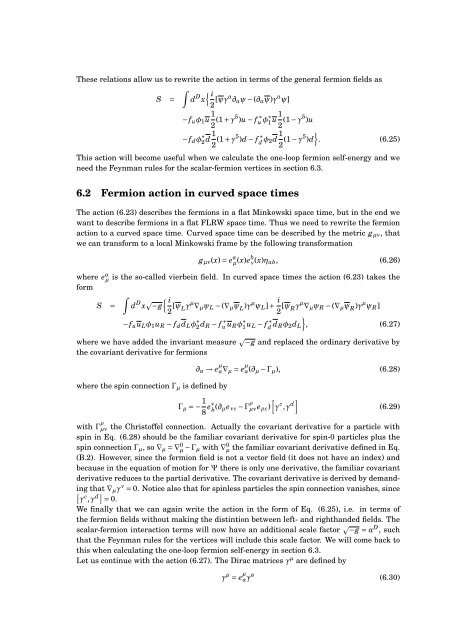Master's Thesis in Theoretical Physics - Universiteit Utrecht
Master's Thesis in Theoretical Physics - Universiteit Utrecht
Master's Thesis in Theoretical Physics - Universiteit Utrecht
Create successful ePaper yourself
Turn your PDF publications into a flip-book with our unique Google optimized e-Paper software.
These relations allow us to rewrite the action <strong>in</strong> terms of the general fermion fields as∫ iS = d x{ D 2 [ψγa ∂ a ψ − (∂ a ψ)γ a ψ]−f u φ 1 u 1 2 (1 + γ5 )u − fu ∗ φ∗ 1 u 1 2 (1 − γ5 )u−f d φ ∗ 2 d 1 2 (1 + γ5 )d − f ∗ d φ 2d 1 }2 (1 − γ5 )d . (6.25)This action will become useful when we calculate the one-loop fermion self-energy and weneed the Feynman rules for the scalar-fermion vertices <strong>in</strong> section 6.3.6.2 Fermion action <strong>in</strong> curved space timesThe action (6.23) describes the fermions <strong>in</strong> a flat M<strong>in</strong>kowski space time, but <strong>in</strong> the end wewant to describe fermions <strong>in</strong> a flat FLRW space time. Thus we need to rewrite the fermionaction to a curved space time. Curved space time can be described by the metric g µν , thatwe can transform to a local M<strong>in</strong>kowski frame by the follow<strong>in</strong>g transformationg µν (x) = e a µ (x)eb ν (x)η ab, (6.26)where e a µ is the so-called vierbe<strong>in</strong> field. In curved space times the action (6.23) takes theform∫S = d D x i−g{2 [ψ L γµ ∇ µ ψ L − (∇ µ ψ L )γ µ ψ L ] + i 2 [ψ R γµ ∇ µ ψ R − (∇ µ ψ R )γ µ ψ R ]−f u u L φ 1 u R − f d d L φ ∗ 2 d R − f ∗ u u Rφ ∗ 1 u L − f ∗ d d Rφ 2 d L}, (6.27)where we have added the <strong>in</strong>variant measure −g and replaced the ord<strong>in</strong>ary derivative bythe covariant derivative for fermionswhere the sp<strong>in</strong> connection Γ µ is def<strong>in</strong>ed by∂ a → e µ a∇ µ = e µ a(∂ µ − Γ µ ), (6.28)Γ µ = − 1 [8 eν b (∂ µe νc − Γ ρ µνe ρc ) γ c ,γ d] (6.29)with Γ ρ µν the Christoffel connection. Actually the covariant derivative for a particle withsp<strong>in</strong> <strong>in</strong> Eq. (6.28) should be the familiar covariant derivative for sp<strong>in</strong>-0 particles plus thesp<strong>in</strong> connection Γ µ , so ∇ µ = ∇ 0 µ −Γ µ with ∇ 0 µ the familiar covariant derivative def<strong>in</strong>ed <strong>in</strong> Eq.(B.2). However, s<strong>in</strong>ce the fermion field is not a vector field (it does not have an <strong>in</strong>dex) andbecause <strong>in</strong> the equation of motion for Ψ there is only one derivative, the familiar covariantderivative reduces to the partial derivative. The covariant derivative is derived by demand<strong>in</strong>gthat ∇ µ γ ν = 0. Notice also that for sp<strong>in</strong>less particles the sp<strong>in</strong> connection vanishes, s<strong>in</strong>ce[γ c ,γ d] = 0.We f<strong>in</strong>ally that we can aga<strong>in</strong> write the action <strong>in</strong> the form of Eq. (6.25), i.e. <strong>in</strong> terms ofthe fermion fields without mak<strong>in</strong>g the dist<strong>in</strong>tion between left- and righthanded fields. Thescalar-fermion <strong>in</strong>teraction terms will now have an additional scale factor −g = a D , suchthat the Feynman rules for the vertices will <strong>in</strong>clude this scale factor. We will come back tothis when calculat<strong>in</strong>g the one-loop fermion self-energy <strong>in</strong> section 6.3.Let us cont<strong>in</strong>ue with the action (6.27). The Dirac matrices γ µ are def<strong>in</strong>ed byγ µ = e µ aγ a (6.30)
















